What could be cuter than puffy little hawk-faced chickens that lay blue eggs? The Ameraucana is a relatively new, homegrown breed of chicken that rocks prominent muff and beard feathering below its laser-sharp beady eyes. It is a distinct breed of its own that is available in an assortment of color variations, but they all lay exquisite blue-shelled eggs.
As a veterinarian and chicken owner of more than forty years, I have seen a lot of trendy chicken breeds come and go. However, the charm and delight of finding beautiful blue eggs in the laying boxes every day never gets old. Let me share more about the Ameraucana breed so you can decide if they will be a good way to add a splash of blue to your coop.
So, What Are Ameraucana Chickens?
English can be confusing, and many words and names sound very similar but have entirely different meanings. Ameraucana is one of these words, so before we go on, let’s run through a quick list of similar-sounding words and their definitions so you can share information and speak confidently about Ameraucana chickens without any mixups.
- American – A citizen, product, or characteristic of the United States.
- Americana – Pertaining to American culture. It can be a genre of music like rock and roll or could be ideas that refer to American culture—things like apple pie and the wild west.
- Araucana – A breed of domestic chicken from Chile that lays blue-shelled eggs.
- Americana or Americauna – There are no such breeds. If you see adverts with these spelling variations, keep on scrolling. It is usually an attempt to pass off Easter Eggers as Ameraucana chicks by baffling poultry buyers with confusing spelling. If you want them, there is nothing wrong with Easter Eggers, but they are not the same as Ameraucana chickens.
- Ameraucana – The topic of this article. An American chicken breed on its own. It can be lots of colors, has cute puffy neck feathers, and lays blue eggs.
In some other countries, including Australia and UK, Ameraucanas and Araucanas are sometimes bundled together because both produce blue eggs, and they are not viewed as separate breeds. However, there are plenty of marked differences both in appearance and health.
Now that we have that confusing name issue out of the way, let’s dig in and find out more about Ameraucana chickens, why they are so unique, and how they differ from their south American cousins.
History
No one seems to agree on what exactly went into creating the breed we now know as Ameraucana chickens. The only certainty is that they are distantly related to Araucana chickens – they share one or two similarities and plenty of differences.
The breed standard of perfection for Ameraucana chickens that was accepted by APA in 1984 is physically significantly different from the South American Araucana. The two breeds should not be confused.
According to master breeder of Ameraucana chickens, John W Blehm, Ameraucanas and Araucanas both arose from chickens that could produce blue eggs. Other than that, they have each followed different paths to becoming breeds on their own.
Appearance
The most notable physical characteristic of Ameraucana chickens is their prominent feather muffs and beards. Since the feathers around their throat and beaks look permanently puffed up, their little bay-red eyes appear beady.
Ameraucana chickens always have muffs, pea combs, and tails. These are distinguishing features of the breed – if you see a chicken that lays blue eggs without a tail, it is either an Araucana or some type of Easter Egger, but it is not an Ameraucana chicken.
Muffs and beards should not be confused with ear tufts. Ameraucana chickens do not have long ear tufts – they have a region of small puffy feathers around the bottom section of their faces.
Wattles on the breed are often nonexistent or very small. The neck region is also hard to see because of the array of poofy neck feathers. Ameraucana chickens have small red pea combs. Leg color depends on the feather color, which can be variable.
Colors
Poultry owners are spoiled for choice when it comes to Ameraucana chicken colors. There are 9 APA accepted color varieties in the standard-size birds and 8 in the bantam division. These include:
| Ameraucana Standard Size Colors | Ameraucana Bantam Size Colors |
|---|---|
| Black | Black |
| Blue | Blue |
| Blue Wheaten | Blue Wheaten |
| Brown Red | Brown Red |
| Buff | Buff |
| Silver | Silver |
| Wheaten | Wheaten |
| White | White |
| Self Blue (also sometimes called Lavender) | – Not yet accepted |
The combs are always red in every color variety. Legs are always clean, but the leg color can vary depending on the feather color, but the bird’s skin and the bottom of its feet must be white.
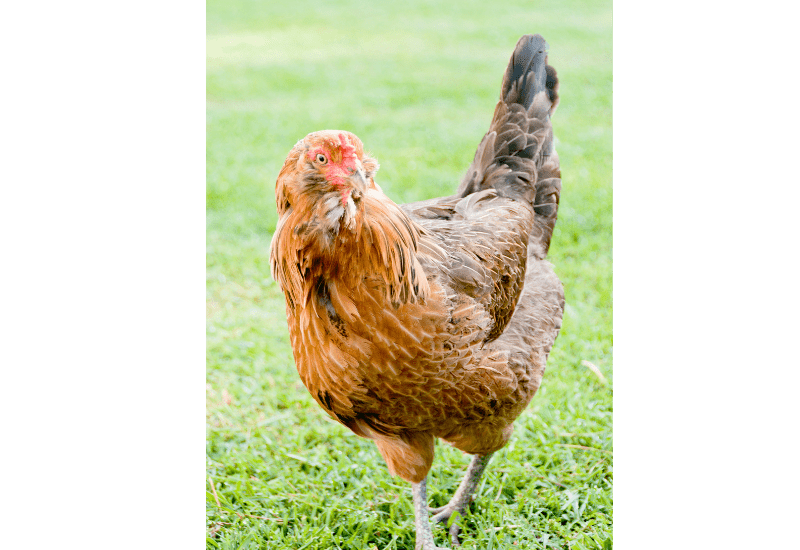
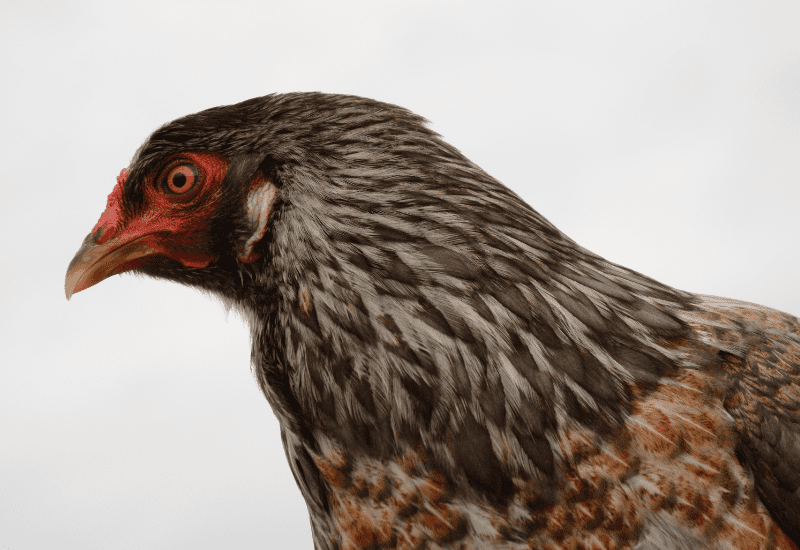
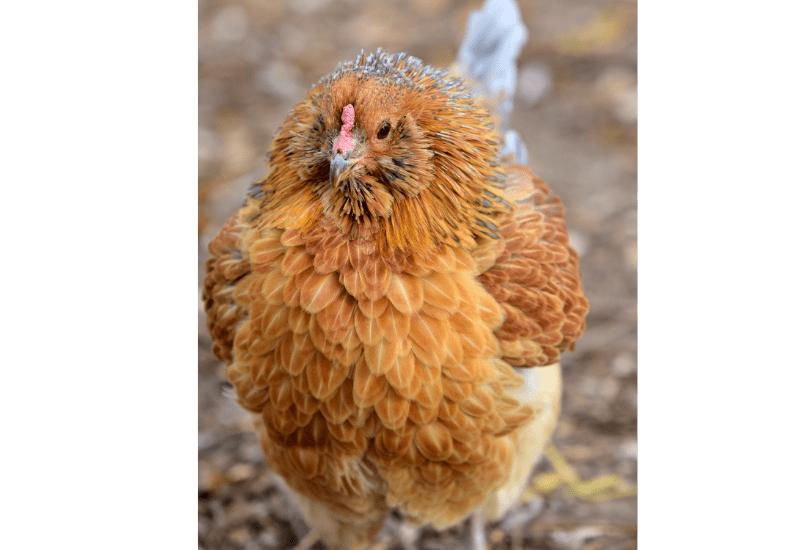
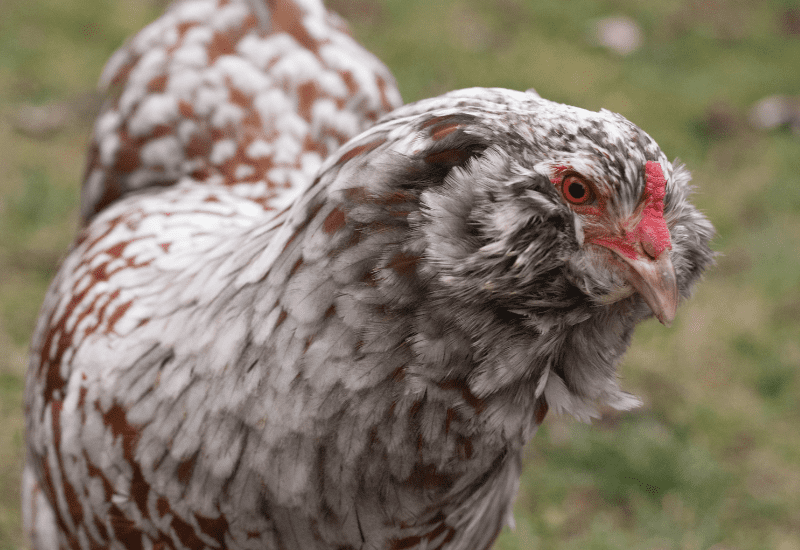
Ameraucana Size And Weight
Standard-size Ameraucana chickens are medium-sized birds known for their beautiful blue eggs. Since the breed is also available as a bantam, there can be a lot of variation in size, but they will never become huge or heavy. Even the tallest birds will only ever be around 18″ tall.
The accepted weights for Ameraucanas are as follows:
Adult Standard Weight: Roosters 5.5-6.5lbs Hens: 4.5 – 5.5lbs
Adult Bantam Weight: Roosters: 26 – 30oz Hens: 24-26oz
Ameraucana Rooster Vs. Hen. How To Tell The Difference
Sexing Ameraucana chicks is usually done by vent-sexing, but it is incredibly difficult to tell the males and females apart even using this method. If you are ordering a batch of day-old pullets, expect to receive a few roosters along with your girls.
As they mature, the differences between Ameraucana roosters and hens become more apparent. One of the first notable features is the development of a comb in male birds. While neither sex in this breed ever has huge headgear, females often resemble hawks because of the lack of comb development.
Of course, at around six months, roosters start crowing, and pullets will begin producing their distinctive, blue-shelled eggs, and physical differences will be apparent. These are some things to look out for:
| Rooster | Hen |
|---|---|
| Usually slightly larger when mature | Smaller adult size to roosters |
| Longer hackle feathers and tails | Shorter hackle feathers and tail |
| Larger comb | Much smaller comb – sometimes hardly visible |
| May have small visible wattles | Almost never have visible wattles |
Egg Production: Are Ameraucana Chickens Good Layers?
Most poultry owners that keep Ameraucanas do so because of the blue-shelled eggs that they produce. Although there is no additional nutritional value or health benefits to having colored eggs, they add an attractive dash of unexpected color to egg trays.
Ameraucana hens will lay about 200 blue eggs each year. As all poultry owners know, a hen’s laying cycle is determined by the amount of available light, and most breeds require at least 12 hours of light per day to lay to their full potential. Laying can slow down when daylight hours are less during winter.
Hens can be encouraged to continue laying through winter by adding supplemental coop lighting. However, this needs to be done gradually, and like most breeds, Ameraucana hens may benefit from having a natural rest over the winter months.
What Color Eggs Do Ameraucana Chickens Lay?
Ameraucana hens lay light blue eggs, which is a consistent trait of the breed. Each egg is a work of art that can be shown off and shared with pride. Your gorgeous eggs will be the envy of the neighborhood.
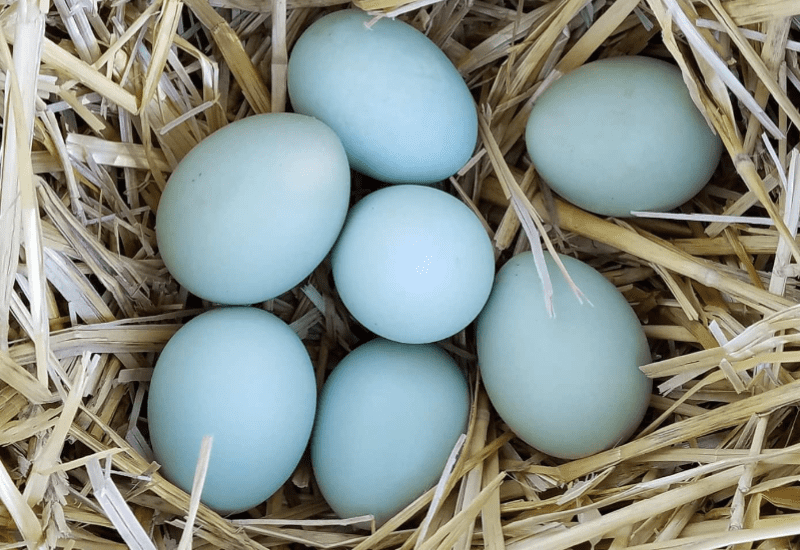
What Age Do Ameraucana Chickens Lay?
Ameraucana hens that are in good health will begin to lay at around six months of age. When hens start to lay, they should be provided with a laying feed or oyster shell supplement in addition to their balanced chicken feed ration (not the same as scratch) to support their increased calcium requirement.
Are Ameraucana Chickens Broody?
Ameraucana hens enjoy a life of independence and rarely become broody. However, if they do and you want more chicks, collect gorgeous blue fertile eggs from all your Ameraucana hens and let your mother-to-be hatch out a decent number rather than just the ones she laid herself.
Once an Ameraucana has opted into motherhood, they are excellent and devoted moms. However, since the breed is not known for its high broodiness, this is not a reliable way for small-scale poultry owners to extend their flock, and you may need to invest in a small electric incubator.
Personality
While researching the breed, some key traits about their personality stand out. They have been described as:
- Sweet
- Curious
- Busy
- Independent
- High energy
- Affectionate but don’t enjoy being picked up
- Easy-doers
- Laid back and not flighty
All in all, Ameraucana chickens are a super addition to any coop. While they can cope in confinement if they have sufficient space and stimulation, this breed appreciates free ranging.
Are Ameraucana Chickens Aggressive?
Ameraucana hens tend to be quite docile. Their grumpy-looking fluffy faces can make them look a little fierce, but in reality, they just roll with the activities at hand. If they feel threatened, they are more likely to move out of an area to avoid conflict.
Having said that, some Ameraucana owners have noted the odd aggressive rooster. Personality differences seem to be a combination of genetics and environment.
While most birds are relaxed and happy to follow the chicken rules, there may be one who may be a little more confrontational – although this can be a useful protection factor for the flock, especially if the birds are free rangers. It is always best to be vigilant, especially if small children are around.
Are Ameraucana Chickens Friendly?
Ameraucana hens look permanently broody and grumpy. However, it’s just their outer covering, and despite their appearance, they are a friendly breed. They are sweet and docile birds that love to get on with their daily business of keeping their beady eyes peeled for potential predators and foraging for snacks.
Ameraucanas are curious and interested in their surroundings. If they are settled in their environment, they often run toward their owners in anticipation of some tasty treats. They enthusiastically accept snacks that are being offered by hand.
Things will never be boring in your yard if you add some of these interesting and unusual hens to your flock. If they have enough space to roam and their basic chicken requirements are met, they will fit in quietly with the rest of the flock and are not known to be troublemakers.
Are They Good For Novice Chicken Keepers?
Ameraucana chickens can be an excellent breed for novice chicken keepers – so long as you actually acquire proper Ameraucana chicks and not a mixed breed that you are not expecting. Chicks must be sourced from a reputable breeder.
Not all eggs that hatch from blue eggs are Ameraucana, and there is plenty of creative marketing that goes on in this regard. Don’t be a novice that falls into this trap and pays top dollar for birds that aren’t what you thought they were.
There are some great reasons why Ameraucanas can be an excellent choice for novice chicken owners:
- They are docile and curious but aren’t over-friendly
- Hens are good layers
- Lay beautiful blue eggs
- Hardy breed with no particular health problems
- They do well as free-range chickens
- Their puffy, hawk-like appearance makes them appear formidable, which seems to positively impact their ability to deter predators.
- No large comb to take care of in winter
- Relatively heat tolerant so do well in a range of climatic conditions
- They aren’t particularly noisy compared to some other chicken breeds.
- Their lifespan of around 7 to 8 years if they are well cared for, so they make great pets
With the positives, novice chicken keepers should also consider the possible downside of owning Ameraucana chickens:
- Lighter colors like white may stand out for predators more camo shades in free-range situations
- Ameraucana chicks are very tricky to sex accurately, so you may end up with more roosters than expected
- Adult roosters can be a little protective of their territory, so it is something to consider if you have young children. However, they are usually friendly, although they may not like to be picked up, carried around, or cuddled excessively.
- Special drinkers may be necessary for cold winter areas to prevent muff and beard feathers from getting wet and freezing.
Ameraucana Health
Besides the outward physical differences, one of the most important differentiating factors between an Ameraucana chicken and an Araucana is that they do not carry the potentially deadly tufted ear gene, which causes high rates of premature death shortly before hatching.
Ameraucana chickens are hardy and can do well in various temperature conditions. The pea combs mean that they are less prone to painful frostbitten combs in winter.
The flip side is that care must be taken to prevent their chubby chipmunk cheek and chin feathers from getting wet and freezing into icicles. Shelters must always be cozy yet well-ventilated and free of drafts.
Like all chickens, birds need a good diet and sufficient space to thrive. If they are kept confined, they must be provided with stimulation to avoid developing behavioral problems, like pecking and egg eating due to boredom. They are an active and curious breed well suited to free ranging.
Ameraucana’s Heat Tolerance
Another appealing feature of the Ameraucana is its hardiness and ability to cope in most climates. Their tiny pea combs make them less likely to suffer from frostbite, and they also seem to cope with heat well, so long as they have sufficient methods to cool down when necessary.
Some easy ways that owners can use to keep their chickens cool when temperatures soar include:
- Ensuring that there is plenty of shade where birds can shelter
- Providing extra water points around the yard and adding ice to drinkers
- Providing extra ventilation to coops or adding a fan
- Remove any stressors like playful dogs or curious children from the environment so birds can stay still and not have to run about during the heat of the day.
- Provide cool treats like melons, lettuce, or cucumbers. Frozen peas make a delightful cold treat in sweltering weather.
Where To Buy Ameraucana Chickens
If you decide that Ameraucana chickens are the right breed for you, take some time to find a reputable breeder. Check the feedback on online sites and get advice from The Ameraucana Alliance. The Ameraucana is an all-American breed, so reliable help is close at hand.
If you simply want a chicken that lays blue eggs, it is fine to take a chance, as several breeds, including Araucana and many Easter Eggers, will be able to do that. However, if you want genuine Ameraucana chicks, it pays to ensure that you do your homework to find birds that display all the characteristic hallmarks of the breed.
Ameraucana chicks will cost considerably more than mixed breeds that ‘lay blue eggs.’ Keep this in mind when looking for breeders, as many suppliers are selling mixed breeds using a lot of creative name variations.
True Ameraucana chicks will cost at least $20 per chick, and there may even be a short waiting period to receive quality birds. Also, be warned that you may not receive 100% hen chicks if that’s what you order, as the little ones are incredibly difficult to sex accurately.
Frequently Asked Questions
Are Ameraucana Chickens Good To Eat?
Like all chickens, Ameraucanas can be eaten, but they are relatively small compared to larger meat breeds like a broiler, Cornish cross, or Jersey Giant. Pure-bred Ameraucana chickens may be a little too expensive and slow-growing to consistently deliver table meat, but excess birds can certainly make a decent meal.
Are Ameraucana Roosters Aggressive?
Ameraucana roosters are sometimes described as grumpy, but they are not usually aggressive. Most owners report that rooster temperament can differ between individuals. There may be the odd bad apple in the basket, but most Ameraucana roosters are vigilant and protective, and they are not known for their aggression.
Share this article with family and friends if you enjoyed learning more about this homegrown American breed of chicken that lays exquisite blue eggs.
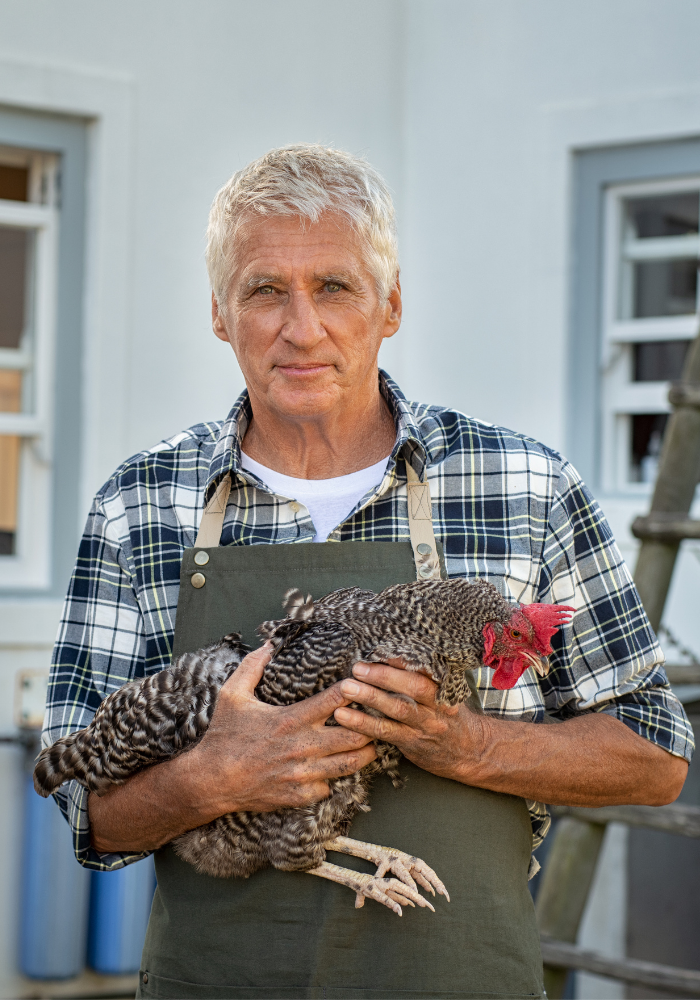
David Cameron is a passionate chicken enthusiast. Growing up, he always wanted to be a veterinarian and loved animals. After graduating from veterinary school, David spent over 40 years as an equine veterinarian. He and his wife retired a few years ago and moved to North Carolina. Here, David’s love of chickens grew even more – he now has 7 chickens and 6 quail. If you have any questions about chickens, feel free to reach out.

